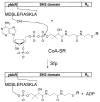Defining SH2 domain and PTP specificity by screening combinatorial peptide libraries
- PMID: 17532507
- PMCID: PMC2041848
- DOI: 10.1016/j.ymeth.2007.02.010
Defining SH2 domain and PTP specificity by screening combinatorial peptide libraries
Abstract
Src homology 2 (SH2) domains mediate protein-protein interactions by recognizing short phosphotyrosyl (pY) peptide motifs in their partner proteins. Protein tyrosine phosphatases (PTPs) catalyze the dephosphorylation of pY proteins, counteracting the protein tyrosine kinases. Both types of proteins exhibit primary sequence specificity, which plays at least a partial role in dictating their physiological interacting partners or substrates. A combinatorial peptide library method has been developed to systematically assess the sequence specificity of SH2 domains and PTPs. A "one-bead-one-compound" pY peptide library is synthesized on 90-microm TentaGel beads and screened against an SH2 domain or PTP of interest for binding or catalysis. The beads that carry the tightest binding sequences against the SH2 domain or the most efficient substrates of the PTP are selected by an enzyme-linked assay and individually sequenced by a partial Edman degradation/mass spectrometry technique. The combinatorial method has been applied to determine the sequence specificity of 8 SH2 domains from Src and Csk kinases, adaptor protein Grb2, and phosphatases SHP-1, SHP-2, and SHIP1 and a prototypical PTP, PTP1B.
Figures






Similar articles
-
Decoding protein-protein interactions through combinatorial chemistry: sequence specificity of SHP-1, SHP-2, and SHIP SH2 domains.Biochemistry. 2005 Nov 15;44(45):14932-47. doi: 10.1021/bi051408h. Biochemistry. 2005. PMID: 16274240
-
Determination of the binding specificity of the SH2 domains of protein tyrosine phosphatase SHP-1 through the screening of a combinatorial phosphotyrosyl peptide library.Biochemistry. 2000 Oct 31;39(43):13251-60. doi: 10.1021/bi0014397. Biochemistry. 2000. PMID: 11052678
-
Alternative mode of binding to phosphotyrosyl peptides by Src homology-2 domains.Biochemistry. 2005 Sep 13;44(36):12196-202. doi: 10.1021/bi050669o. Biochemistry. 2005. PMID: 16142918
-
Probing the phosphopeptide specificities of protein tyrosine phosphatases, SH2 and PTB domains with combinatorial library methods.Curr Protein Pept Sci. 2002 Aug;3(4):365-97. doi: 10.2174/1389203023380594. Curr Protein Pept Sci. 2002. PMID: 12370002 Review.
-
Revealing mechanisms for SH2 domain mediated regulation of the protein tyrosine phosphatase SHP-2.Structure. 1998 Mar 15;6(3):249-54. doi: 10.1016/s0969-2126(98)00027-6. Structure. 1998. PMID: 9551546 Review.
Cited by
-
Both Intrinsic Substrate Preference and Network Context Contribute to Substrate Selection of Classical Tyrosine Phosphatases.J Biol Chem. 2017 Mar 24;292(12):4942-4952. doi: 10.1074/jbc.M116.757518. Epub 2017 Feb 3. J Biol Chem. 2017. PMID: 28159843 Free PMC article.
-
High-throughput sequencing of peptoids and peptide-peptoid hybrids by partial edman degradation and mass spectrometry.J Comb Chem. 2009 Mar 9;11(2):294-302. doi: 10.1021/cc8001734. J Comb Chem. 2009. PMID: 19154119 Free PMC article.
-
A Peptidyl Inhibitor that Blocks Calcineurin-NFAT Interaction and Prevents Acute Lung Injury.J Med Chem. 2020 Nov 12;63(21):12853-12872. doi: 10.1021/acs.jmedchem.0c01236. Epub 2020 Oct 19. J Med Chem. 2020. PMID: 33073986 Free PMC article.
-
Engineered SH2 domains with tailored specificities and enhanced affinities for phosphoproteome analysis.Protein Sci. 2019 Feb;28(2):403-413. doi: 10.1002/pro.3551. Epub 2018 Dec 24. Protein Sci. 2019. PMID: 30431205 Free PMC article.
-
The conundrum of inhibitory signaling by ITAM-containing immunoreceptors: potential molecular mechanisms.FEBS Lett. 2010 Dec 15;584(24):4878-82. doi: 10.1016/j.febslet.2010.09.029. Epub 2010 Sep 28. FEBS Lett. 2010. PMID: 20875413 Free PMC article. Review.
References
-
- Venter JC, et al. Science. 2001;291:1304–1351. - PubMed
-
- Waksman G, Kominos D, Robertson SC, Pant N, Baltimore D, Birge RB, Cowburn D, Hanafusa H, Mayer BJ, Overduin M, Resh MD, Rios CB, Silverman L, Kuriyan J. Nature. 1992;358:646–653. - PubMed
-
- Blaikie P, Immanuel D, Wu J, Li N, Yajnik V. B Margolis J Biol Chem. 1994;269:32031–3203. - PubMed
-
- Songyang Z, Shoelson SE, Chaudhuri M, Gish G, Pawson T, Haser WG, King F, Roberts T, Ratnofsky S, Lechleider RJ, Neel BG, Birge RB, Fajardo JE, Chou MM, Hanafusa H, Schaffhausen B. L C Cantley Cell. 1993;72:767–778. - PubMed
-
- Burshtyn DN, Yang W, Yi T, Long EO. J Biol Chem. 1997;272:13066–13072. - PubMed
Publication types
MeSH terms
Substances
Grants and funding
LinkOut - more resources
Full Text Sources
Research Materials
Miscellaneous

